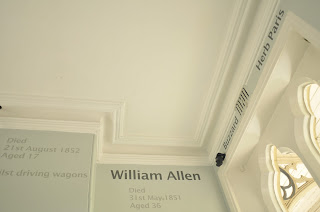UCA Gallery Space

The recent exhibition Journeys and Reflections created by artists Jo Roberts and Stephen Turner in response to a commission from the Kent Architecture Centre was unveiled in the UCA Gallery space in The Pentagon Centre in Chatham in North Kent at the end of October (22nd-27th). Once a beacon of the modern shopping experience, The Pentagon now seems out moded. I used to shop there and never did I think the shopping experience was the pinnacle of capitalist enlightenment that I am sure the architects of the Pentagon had in mind when they designed the concrete arrow of style. Nevertheless, like many such shopping centres from this era, it evokes a nostalgia in me, admiration even. I cannot fail to enjoy this neon stark, retail experience. It's vintage.
In this environment a gallery space is a stroke of genius. Artists have a direct connection to untapped audiences, people who may never feel comfortable going to a regular art gallery. They may just be curious enough to come in and engage in contemporary art en route to the toy shop next door. I hope so because the exhibition is all about the margins of life, the beauty and unexpected or overlooked that get caught like flotsam in the edges of places. Roberts and Turner extract these delicacies through hand drawn daily maps (Roberts) and botanical essences (Turner) and encourage us to re-evaluate these places.
'Edgelands...' write Farley and Symmons-Roberts in their book of the same name, '...are not meant to be seen, except as a blur from a car window or as a backdrop to our most routine and mundane activities.' Roberts and Turner have mined this rich, often ignored seam which exists in these edgelands and created work which calls for the senses to take note - to smell, to calculate, to excavate a place off centre, to document journeys or plants. A forensic exploration of a place.

Work by Jo Roberts

Roberts cycled around these fringes of Swale and Medway in Kent asking people where this Urban fringe might be located and subsequently produced hand drawn and painted 70 Maps of the Day. These maps were tweeted daily which I received via my Twitter feed. They were current for a short time on Twitter, soon eaten up by other tweets of chatter. Seeing the collection of 70 Maps hand crafted and of an intimate scale was more beautiful and resonating. On Twitter, the maps were as Farley and Symmons-Roberts noted about the journey through these Edgleland, seen in the 'blur from the car window'. In the gallery space, I had opened the car door, smelt the air (thick with Turner's botanical essences) and seen the fringe.
Artists are canny at finding places which are undervalued, grimy: spaces which niggle the obsessive bureaucrats who want to dismantle the uncomfortable truths about the discrepencies of society. These places along the fringes are usually cheap, economically in decline- the scar tissue of constant wounds inflicted. Artists observe though and find value where others see only particles of failings. Turner, like a shaman, has long found the lyrical that exists around Medway and Swale through tinkering with the tricky, the forgotten or abandoned places battered by industry, military or the geographically inaccessible.

Guided by Faith, a fly tipped doll retrieved from Sittingbourne, Turner collected aromatic plants that thrive alongside tips & waste processing plants of the area. Through alchemical processes, Turner collected the individual aromas of specimens which were presented at the opening of the show on Saturday 22nd October to unsuspecting visitors. Like a kind of ad-hoc rogue pharmaceutical company, Turner had created testing stations where visitors were invited to smell these individual aromas and comment on how they made you feel, what they reminded you of and if you liked them. There were cups of coffee grains available to clear your nose from particularly pungent ones and not mash up the essences of these fringe plants. Gathering all of this information, Turner would then select and mix a unique fragrance like a perfumier of the North Kent marshes. The resulting essence is to be named Eau Du Bordure and will be available as a limited edition.
Stephen Turner
This surely is a poignant thing- a scent of a place that will change, will move from borderlands, may be gentrified one day under a canopy of red and buff bricks and promised lifestyles that will teeter along these fringes. The notion of what constitutes the fringe will have been archived for posterity and the hand made maps by Roberts will be charming vignettes of a life that used to exist, briefly, before Boris's army invaded.
Bottles of plant essences collected and arranged by Stephen Turner.
Sample of Yarrow, gathered from the Urban Fringes by Turner.
Edgelands; Journeys into England's True Wilderness,2011 Farley, P. & Symmons Roberts, M., Jonathan Cape, London.
























